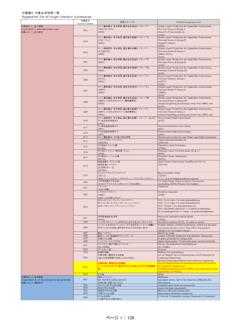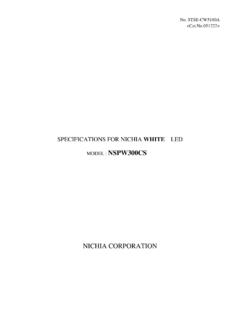Transcription of DATA SHEET - CITIZEN
1 data SHEET . CITILED COB Series Standard Type Ra70,80 Min. Model CLU048-1212C4. Introduction P 2. Performance Characteristics P 3. Mechanical Dimensions P 5. Characteristic Curves P 6. Reliability P 9. Packing Specification P 10. Precaution P 11. 1. 05/16. Product Nomenclature CLU048 - 12 12 C4 - 27 3 M2 K1. [1] [2] [3] [4] [5]. [1] Product shape CLU048. [2] Die count in series 12. [3] Die count in parallel 12. [4] Nominal CCT 2700K. [5] CRI (Ra) 1. Introduction 1-1. Product Description CITIZEN ELECTRONICS is the first COB manufacture. Our advanced knowledge and packaging technology for many years has excellent reliability and high quality of our products. CITILED COB Series covers a wide range of luminous flux from a 10W incandescent bulb to a 500W mercury lamp in general lighting sources. The element arrangement of LED. package is capable of utilizing light more effectively and higher performance.
2 The new version of CITILED COB Series succeed to reduce the thermal resistance significantly. New version creates more options to match luminaire's products design (ex. High performance , Cost effective , Higher lumen density , Increased allowable max. If). The outline and LES size is same since version 1. 3-step MacAdam ellipse color definition at Tj=85 is available. 1-2. Features 2. 05/16. 2. Performance Characteristics 2-1. Electro Optical Characteristics ( Tj=85C ). Luminous flux Thermal CRI Efficacy Forward Voltage Nominal ( lm ) Resistance Product code ( lm/W ) Current ( V). CCT Ra R9 T =85C Tc=25C* Rj-c ( mA ). ( C/W ). Min. Min. Min. Typ. Typ. Typ. Min. Typ. Max. CLU048-1212C4-273M2K1 2700K 80 0 4,682 5,321 5,839 142 1,080 CLU048-1212C4-303M2K1 3000K 80 0 4,894 5,562 6,104 149 1,080 CLU048-1212C4-353M2K1 3500K 80 0 4,993 5,674 6,227 152 1,080 CLU048-1212C4-403M2K1 4000K 80 0 5,045 5,734 6,293 153 1,080 CLU048-1212C4-503M2K1 5000K 80 0 5,117 5,815 6,382 155 1,080 CLU048-1212C4-573M2K1 5700K 80 0 5,168 5,873 6,445 157 1,080 CLU048-1212C4-653M2K1 6500K 80 0 5,209 5,920 6,497 158 1,080 CLU048-1212C4-30AL7K3 3000K 70 - 5,171 5,877 6,450 157 1,080 CLU048-1212C4-40AL7K3 4000K 70 - 5,340 6,069 6,660 162 1,080 CLU048-1212C4-50AL7K3 5000K 70 - 5,421 6,161 6,761 165 1,080 Notes : 1.
3 CITIZEN Electronics maintains forward voltage +/-3%, luminous flux +/-10%,Ra and R9 +/-1. *Values of Luminous flux at Tc=25C are provided as reference only. 2-2. Absolute Maximum Ratings Parameter Symbol Rating Input Power (W) Pi *1. Forward Current (mA) If 2760 *1. Reverse Current (mA) Ir 1. Operating Temperature (C) Top -40 ~ +100. Storage Temperature (C) Tst -40 ~ +100. Case Temperature (C) Tc 105 *2. Junction Temperature (C) Tj 140 *3. *1. Input power and forward current are the values when the LED is used within the range of the derating curve in this data SHEET . *2. Refer to 3. Outline drawing for Tc measurement point. *3. Current : Tj = Tc + Rj-c Pi 3. 05/16. 2-3. Chromaticity Characteristics ( Rated current, Tj=85C ). Oval parameter Nominal Center Point Ellipse Color Region Major Axis Minor Axis CCT ( x, y ) Rotation Angle a b . 2700K ( , ) 3000K ( , ) 3500K ( , ) 3-step MacAdam ellipse 4000K ( , ) 5000K ( , ) 5700K ( , ) 6500K ( , ) ANSI parameter Nominal Center Point Color Region a b c d CCT ( x, y ).
4 ( x, y ) ( x, y ) ( x, y ) ( x, y ). 3000K ( , ) ANSI C78. 377:2011 4000K ( , ) 5000K ( , ) * Color region stay within MacAdam 3-step ellipse from the chromaticity center. * The chromaticity center refers to ANSI :2011. Please refer to ANSI C78. 377 for the chromaticity center. x-y chart CIE1931. 2,700K. 3,000K. 3,500K. 4,000K Black Body Locus 5,000K. y 5,700K. 6,500K. ANSI. 3-step x Note : CITIZEN Electronics maintains chromaticity ( x, y ) + 4. 05/16. 3. Mechanical Dimensions Internal Circuit Marking 1 : Serial No. Marking 2 : H 12 12 ** ** Protection device CRI. Anode Cathode CCT. Dies count in parallel LED device Dies count in series CLU048 12 s 12 p 5. 05/16. 4. Characteristic Curves 4-1. Forward Current Characteristics / Temperature Characteristics Forward Current vs. Forward Voltage Forward Current vs. Relative Luminous Flux Tc=25C Tc=25C.
5 250%. Relative Luminous Flux [ ]. 200%. Vf [V]. 150%. 100%. 50%. 0%. 0 1000 2000 3000 0 1000 2000 3000. If [mA] If [mA]. Case Temperature vs. Forward Voltage Case Temperature vs. Relative Luminous Flux If=1080mA If=1080mA. 120%. Relative Luminous Flux [ ]. 100%. 80%. Vf [V]. 60%. 40%. 20%. 0%. 0 25 50 75 100 0 25 50 75 100. Tc [C] Tc [C]. 6. 05/16. 4-2. Optical Characteristics Spectrum : CRI(Ra) 80 Min. Tj=85 If=1080mA. 6500K 5700K 5000K 4000K 3500K 3000K 2700K. 100%. 90%. 80%. Radiative Intensity 70%. 60%. 50%. 40%. 30%. 20%. 10%. 0%. 380 430 480 530 580 630 680 730 780. Wave length [nm]. Spectrum : CRI(Ra) 70 Min. Tj=85 If=1080mA. 5000K 4000K 3000K. 100%. 90%. 80%. 70%. Radiative Intensity 60%. 50%. 40%. 30%. 20%. 10%. 0%. 380 430 480 530 580 630 680 730 780. Wave length [nm]. 7. 05/16. 4-2. Optical Characteristics (continued). Radiation Characteristic -40 -30 -20 -10 10 20 30 40.
6 100%. -50 50 . 80%. 60% 60 . -60 . 40% 70 . -70 . X. 20%. -80 80 . Y. -90 0% 90 . 4-3. Derating Characteristics Case Temperature vs. Allowable Forward Current 3000. 2500. 2000. If [mA]. 1500. 1000. 500. 0. 0 25 50 75 100 125. Tc [C]. 8. 05/16. 5. Reliability 5-1. Reliability Test Test Item Test Condition IF=1080mA Ta=25C (with Al-fin) 1000hrs Continuous Operation Test IF=1080mA Tj=140C (with Al-fin) 1000hrs Low Temperature Storage Test -40 C 1000 hours High Temperature Storage Test 100 C 1000 hours Moisture-proof Test 85 C, 85 %RH for 500 hours Thermal Shock Test -40 C 30 minutes 100 C 30 minutes, 100 cycle 5-2. Failure Criteria ( Tc=25C ). Measuring Item Symbol Measuring Condition Failure Criteria Forward Voltage Vf If=1080mA >U Total Luminous Flux v If=1080mA <S U defines the upper limit of the specified characteristics. S defines the initial value.
7 Note : Measurement shall be taken between 2 hours and 24 hours, and the test pieces should be return to the normal ambient conditions after the completion of each test. 9. 05/16. 6. Packing Specification 6-1. Packing An empty tray is placed on top of a 6-tier tray which contain 30 pieces each. (Smallest packing unit: 180 pieces). A label with product name, quantity and lot number is placed on the upper empty tray. Tray (Dimensions: 310 x 210 x 12 mm / Materials: Electrically conductive PS). Example of indication label 1. TYPE CLU048-1212C4. 2. ( Cutomer's P/N ). 3. Lot No. CUSTOMER 1 5 5 5 0 0 1. TYPE : CLU**-**-** --- ( 1 ) (1) (2) (3). : ** --- ( 2 ). Lot No : ** --- ( 3 ). (1) Last two digit of the year 15 : year 2015. Q'ty : ** --- ( 4 ) (2) Production month 5 : May Note: October, November and December are designated X,Y and Z. (3) CE's control number 4.
8 Quantity 10. 05/16. 7. Precaution 7-1. Handling with care for this product -Both the light emitting area and white rim around the light emitting area is composed of resin materials. Please avoid the resin area from being pressed, stressed, rubbed, come into contact with sharp metal nail ( edge of reflector part) because the function, performance and reliability of this product are negatively impacted. -Please be aware that this product should not come into contact with any other parts while incorporating in your lighting apparatus or your other products. -Please be aware that careful handling is required after the attachment of lead wires to prevent the application of any load to the connections. -For more information, please refer to application note "Instruction Manual(COB LED Package)". 7-2. Countermeasure against static electricity -Handling of this product needs countermeasures against static electricity because this is a semiconductor product.
9 -Please take adequate measures to prevent any static electricity being produced such as the wearing of a wristband or anti-static gloves when handling this product. -Every manufacturing facility in regard to the product (plant, equipment, machine, carrier machine and conveyance unit). should be connected to ground and please avoid the product to be electric-charged. -ESD sensitivity of this product is over 1000V (HBM, based on JEITA ED-4701/304). -After assembling the LEDs into your final product(s), it is recommended to check whether the assembled LEDs are damaged by static electricity (electrical leak phenomenon) or not. -It is easy to find static damaged LED dies by a light-on test with the minimum current value. 7-3. Caution of product assembly -Regarding this product assembling on the heat sink, it is recommended to use M3 screw. It might be good for screw tightening on the heat sink to do temporary tightening and final tightening.
10 In addition, please don't press with excess stress on the product. -The condition of the product assembling on the heat sink and the control of screw tightening torque needs to be optimized according to the specification of the heat sink. -Roughness, unevenness and burr of surface negatively impact thermal bonding between the product and heat sink and increase heat thermal resistance between them. Confidence of thermally and mechanical coupling between the product and heat sink are confirmed by checking the mounting surface and measuring the case temperature of the product. -In order to reduce the thermal resistance at assembly, it might be good to use TIM (Thermal Interface Material) on whole contact surface of the product. In case of using thermal grease for the TIM, it might be good to apply uniformly on the contact surface of the product. In case of using thermal SHEET for the TIM, it might be good to make sure that the product is NOT strained by stress when the screws are tightened for assembly.










